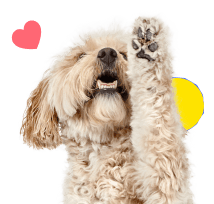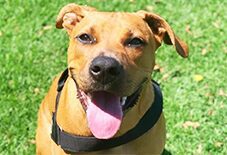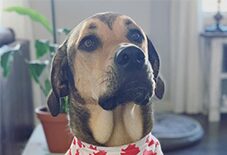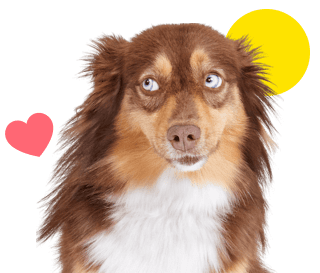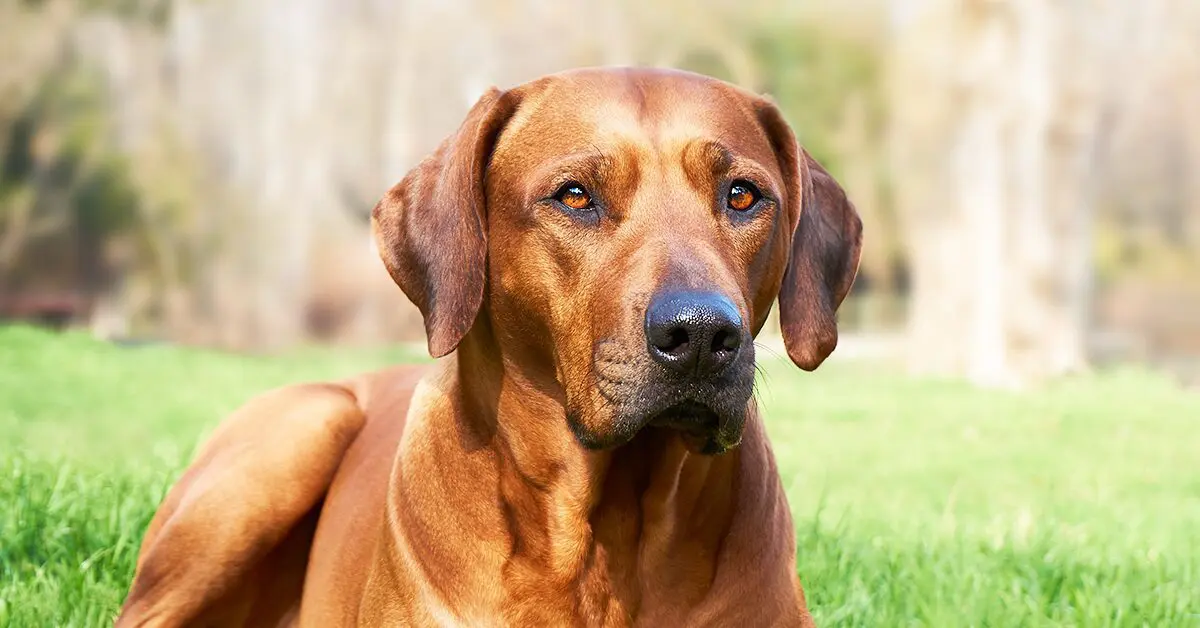
Meet the Rhodesian Ridgeback
High Doggy I.Q.
Pawfect Playmate
Top Workout Buddy
If you’re in search of an athletic but affectionate pup, look no further! Bred to hunt big animals in South Africa, I’m super strong, energetic, and ready for any outdoor activity. Hiking, fetching, you name it! Just make sure I don’t wander off – we hounds are known to follow our puposterously sharp sense of smell into all sorts of trouble. Keep in mind that I can be a little stubborn (oops!), so I need an owner who knows how to say no. I know it’s hard when you look into my big puppy eyes, but it’s for the best!
Kids have a blast around me, but dogs and cats? Not so much. My guard dog and hunting dog instincts can come out around other animals. I need some time to warm up to humans, but once I do, I’ll give you plenty of love and licks. As a puppy, I can be a little rambunctious, but I tend to simmer down as an adult. One thing I never grow out of is my love for food – so keep an eye on those snacks on the counter before I gobble them up!
Ready to learn more about me? Let’s dig in.
Ready to learn more about me? Let’s dig in.
 My Many Looks
My Many Looks
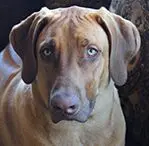
Light Wheaten
Brown Nose
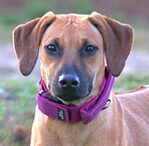
Light Wheaten
Black Nose
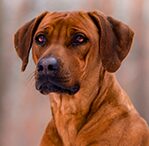
Red Wheaten
Black Nose
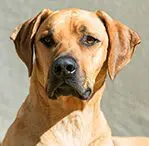
Wheaten
Black Nose
 My Breed Characteristics
My Breed Characteristics
 Furbulous Fact
Furbulous Fact
We’re a brave breed known to stand up to the most ferocious animals – even lions! We earned the nickname African Lion Hounds in our old stomping grounds of Rhodesia, now modern-day Zimbabwe. We accompanied big game hunters on their excursions and always had their backs! Humans tell tales of us winning fights against lions, but that’s not completely true. We would, however, tease lions until they were disoriented enough to leave our humans alone. We also fended off baboons and herded oxen!
 As I Grow Up
As I Grow Up
As you can see, we Rhodesian Ridgebacks age pretty gracefully. Here are a few key milestones in my growth and development to be aware of as I grow up from a pupper to an adult and senior!
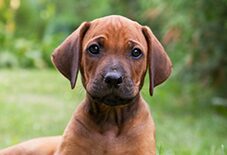
Puppy3-6 Months
I’m small now, but I’m going to be huge! Give me proper obedience training so I don’t jump on and chase you when I’m fully grown.
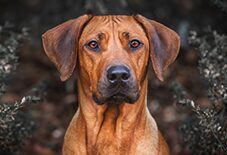
Adult1-3 Years
I love to exercise! Once I’m fully grown, look into activities like weight pulling. These muscles aren’t going to build themselves!

Senior7-11 Years
All those years of chasing my humans around have done a number on my joints! Look into supplements to keep me strong in my old age.
 History of My Breed
History of My Breed
Our dog breed comes from the South African country of Rhodesia, which is now Zimbabwe. We were bred by Boer farmers to be versatile, fearless hunting dogs, with the ability to stand up to big, scary, wild animals! Breeders started by mixing dogs like Greyhounds, Mastiffs, Great Danes, and Bloodhounds with a half-wild dog known as Khoikhoi. Khoikhois had a ridge going down their backs and pups born with the ridge ended up being great hunting dogs!
As big game hunting became more popular in South Africa, we started tagging along with hunters to help them! They discovered we were really good at distracting and teasing predators, like lions, to keep them in place so hunters could get a good shot. When we weren’t working as hunting dogs, Ridgies were known for being loyal companions and family dogs.
The Ridgeback breed started to fade out early in the 1900s as big game hunting started declining in popularity. In the late 19th century, a pretty famous big-game hunter named Cornelius Van Rooyen imported two ridged Greyhound-like females to add to his pack of lion-hunting dogs. He was so impressed with our work that he started a breeding program! Our breed standard was established shortly after and our pup-ularity skyrocketed. The Rhodesian Ridgeback was accepted by the South African Kennel Union in 1924.
We really started to take off after WWII. The famous actor, Errol Flynn, was the first breeder of Rhodesian Ridgebacks in the United States in the 1930s, although it’s believed some of us came to America as early as 1911. He raised us on his Hollywood ranch. Since then, lots of other celebrities have owned members of our breed, like Patrick Swayze! No big deal.
The first Rhodesian Ridgeback, named Tchaika, was registered by the AKC in 1955 and the Rhodesian Ridgeback Club of the United States was established two years later.
 Pawesome Pups to Parent
Pawesome Pups to Parent
In addition to purebred Rhodesian Ridgebacks like me, there are tons of pawfectly sweet mixed-breed Ridgies that are looking to find their furever homes. You can learn where to find your next pet below!
Watch for signs of bloat.
Ridgebacks are at a greater risk of suffering from bloat (GDV). This happens when the stomach fills with air causing pressure to build, which stops blood from returning to the heart. If the stomach flips, it deprives the pancreas of oxygen which then produces harmful toxins. Talk to your vet about gastropexy, which can largely prevent this from happening.
Be aware of complications with the ridge.
Rhodesian Ridgebacks are prone to a rare, but serious, complication involving the ridge on their backs. All puppies should have a thorough first vet visit to determine whether or not that condition may occur in your Ridgie.
Adjust to your Ridgie’s hearing loss (if it occurs).
Rhodesian Ridgebacks sometimes suffer from hearing loss. Most dogs cope incredibly well to hearing loss and learn visual cue training signals. It’s important to be careful not to “sneak up” to them from behind because if they can’t see you coming, they may be more reactive when they notice you.
 Training Tips
from Trainers & Behavioral Specialists
Training Tips
from Trainers & Behavioral Specialists

Interrupt your Ridgie when they're in “predatory mode.”
Ridgebacks are born hunters and some of the only animals that will stand up to lions. They have a lot of energy and a strong predatory instinct, so it’s easy for them to fall into cycles of wanting to hunt things. Watch for the “predatory look” when you’re out with your dog, which is when a dog pauses, focuses on an animal, and hunches over. Interrupt your dog when they're doing that and remove them from the situation. - Richard Lovejoy, Professional Remote Dog Trainer
Make sure your dog doesn’t guard resources.
Be cautious of allowing your Ridgeback to guard resources, like food and toys. If they take something and put it in their bed or one of their regular spots in the house but never use it, train them out of that. Make sure they know that the food and toys are yours, not theirs, and that you control these resources. Don’t allow them to become possessive over things and take toys away if they tend to growl over them. Cycle toys quickly through so they don’t have the chance to start feeling intense ownership. - Richard Lovejoy, Professional Remote Dog Trainer
Teach your Ridgeback good recall.
Rhodesian Ridgebacks usually have a strong prey drive and like to chase squirrels and other small animals. Make sure to start training your Ridgie early for good recall (coming back when called.) - Laurie Williams, Certified Professional Dog Trainer

 Why Get Dog Insurance?
from Pumpkin®
Why Get Dog Insurance?
from Pumpkin®
While Rhodesian Ridgebacks are a generally healthy breed, unexpected ruh-rohs can happen to any dog at any age. If your pup gets hurt or sick, pet insurance can help you say ‘yes’ to the best care, even when it’s costly. When it comes to shopping for this breed, you’ll want to choose insurance plans like Pumpkin's, which can help cover the costs associated with the hereditary conditions Ridgies are prone to developing. While a reputable breeder will conduct genetic testing on your pup’s parents to help minimize the chances of passing down hereditary conditions – they can’t always be avoided. Let’s look at some common ones, and how Pumpkin Dog Insurance plans could help cover the cost of care!
 Dermoid Sinus
Dermoid Sinus
This neural tube birth defect is seen mostly in Ridgebacks. The tubes, found along the neck, back, and tail, are meant to drain dead cells, hair, and tissue, but the defect prevents drainage and leads to infection. Antibiotics and surgery are used to treat this, depending on the severity.
- Cost to Treat
- $1,000-$6,000
- Pumpkin Pays Back*
- $900-$5,400
 Hypothyroidism
Hypothyroidism
Ridgebacks are prone to developing Hypothyroidism, which occurs when a dog’s thyroid gland is underactive, slowing down their metabolism, and negatively affecting major organ functions. While not curable, it can be treated and managed with thyroid replacement hormone therapy.
- Cost to Treat
- $300-$5,000
- Pumpkin Pays Back*
- $270-$4,500
 Hip Dysplasia
Hip Dysplasia
This orthopedic condition happens when the ball and socket of the hip joint doesn’t develop or work properly, leading to joint deterioration, pain, lameness, and/or arthritis. Mild cases can be managed with prescription meds and physical therapy, but severe ones may require costly surgery.
- Cost to Treat
- $1,500-$7,000 (surgical)
- Pumpkin Pays Back*
- $1,350-$6,300
 Degenerative Myelopathy
Degenerative Myelopathy
This is a progressive or chronic condition that affects the spinal cord and can lead to paralysis. It occurs when the white matter of a dog’s spine starts to deteriorate over time, causing symptoms similar to arthritis. Treatments include physical therapy and dietary supplements.
*Example illustrates reimbursement of a covered vet bill at a 90% reimbursement rate, where the annual deductible had already been satisfied and the annual limit had not yet been met. Coverage and reimbursement results vary based on policy options.
